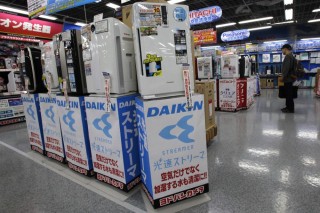Loading
Search
▼ Weak Yen Rekindles Hope for ‘Made in Japan’
- Category:Other

WSJ
Japanese business leaders once again are touting “made in Japan” labels, promising to return production from overseas to take advantage of the yen’s sharp drop, which has reduced the once sky-high cost of manufacturing here.
It isn’t yet clear how much production is actually being shifted, or how many jobs will be created in Japan. The nation still has a big trade deficit, and exports, while recovering somewhat recently, have yet to show the kind of surge anticipated when the yen started to weaken in late 2012.
Analysts say the promise could be realized if the yen remains depressed and others follow the lead of companies such as Canon Inc., Panasonic Corp. and Sharp Corp. In November, exports jumped 10.8% from a year earlier while imports rose only 2.2%, according to new data from the finance ministry.
Bolstering domestic industry is a major goal of Prime Minister Shinzo Abe, who wants to restore Japan to its former status as an export powerhouse. Japanese manufacturers, like those from other developed countries, had been shifting production to China and other cheaper locations for years. These moves accelerated after the 2008-2009 financial crisis, when the yen soared.
Now one dollar buys about ¥117.5 , compared with about ¥80 in mid-2012, meaning Japanese wages and other costs are lower in dollar terms. With Mr. Abe exhorting executives to support his turnaround plans, some manufacturers are returning work home. The shift has been led by the country’s troubled electronics giants, which have lost ground to lower-cost rivals in South Korea and China.
“Moves among major electronics makers to bring back home some of their overseas production have become more pronounced,” Atsushi Miyanoya, manager of the Bank of Japan’s Osaka branch, said earlier this month.
Canon, which has plants in several Asian countries, plans to increase domestic output of its cameras, photocopiers, printers and medical devices, according to a spokesman. The goal, he said, is to raise domestic production to about 60% of total output by value, from about 40% now. That would bring the ratio back to 2009 levels.
Sharp plans to move production of some air purifiers and refrigerators to Japan from China, a spokeswoman said. Manufacturing of some televisions will be shifted to Japan from China and Malaysia, she added. But the company also plans to continue making these products at the existing overseas sites, too.
Daikin Industries Ltd. , a maker of air conditioners, has already shifted some output to Japan from China and might do more this year, the company’s chairman, Noriyuki Inoue, said this month.
“Daikin sees great potential in being able to turn yen depreciation into a positive advantage,” he said.
“When the yen started weakening, there was some time lag, but now, after more than a year, manufacturers have been able to change business plans,” said UBS economist Daiju Aoki. “I think this trend will continue for some time.”
In addition to the cheap yen, Japanese officials have cited rising labor costs in emerging markets, including China—also cited by American manufacturers as a reason for recent moves to return some production to the U.S.
However, Japanese manufacturers are often quick to caution that they have no plans to close facilities overseas.
Many of the reasons to produce overseas remain. Japan, with its stagnant economy and aging population, offers little prospect of growth. Producing overseas allows companies to get closer to customers—and, in case the yen strengthens again, it makes sense for companies to hedge risk by keeping production in the markets where they sell.
Murata Manufacturing Co. , a maker of parts for smartphones and other electronic gadgets, is on track to lift production outside Japan to 30% of its total by March, up from 14% four years ago. The company has been increasing sales to smartphone makers in China and wants to be near them, a spokeswoman said.
Car makers in particular aren’t likely to alter their long-term strategy of shifting assembly overseas, say analysts. Nissan Motor Co. , which makes about 20% of its vehicles in Japan, said last year that it would keep making some engines at a plant in Fukushima after earlier considering a shift to Tennessee. Honda Motor Co. says it might move production of some minibikes to Japan from Vietnam and China. But neither company has announced moves of any core automotive assembly operations.
Akio Toyoda , Toyota Motor Corp. ’s chief executive, said at a New Year’s reception in Tokyo that the company had no plans to bring home manufacturing.
Bringing production back to Japan may make more sense for electronics giants because of quicker product turnover than the five- to 10-year cycles that are typical in the auto industry. The electronics companies also have significant unused capacity in Japan.
Ricoh Co. , which shut a copy-machine plant in Gotemba, Japan, in 2013, affecting 1,200 workers, said this month that it would reopen the site as a development center for environmentally-friendly businesses, employing about 1,000 workers. Other companies, including Panasonic, Toshiba Corp. and Fujitsu Ltd. , have converted former electronics manufacturing sites to the production of vegetables, using high-tech clean rooms.
Sony Corp. said last year that it would invest ¥35 billion ($300 million) to increase production of image sensors for smartphones and tablet computers at several domestic factories.
Overseas capital spending, which rose from less than 13% of total capital expenditure in late 2009, soared to more than 25% in 2013, according to UBS’s Mr. Aoki. Last year the overseas percentage began to fall again—not because companies are cutting back on their foreign operations but because they are spending more at home, he said.
- January 23, 2015
- Comment (0)
- Trackback(0)

